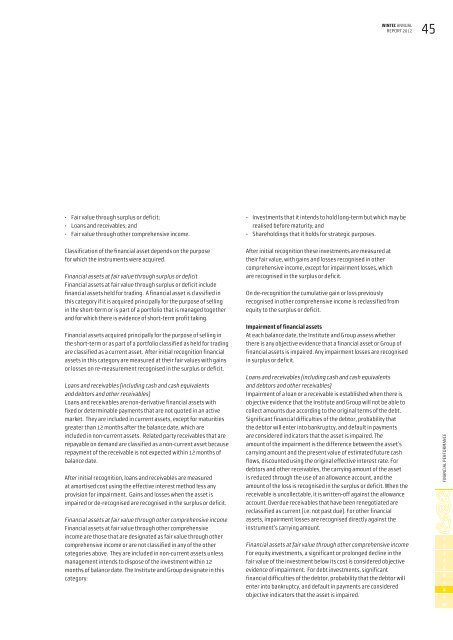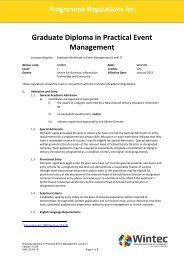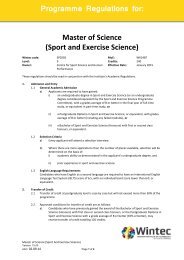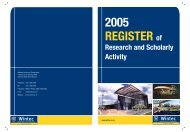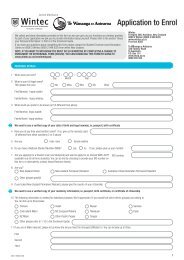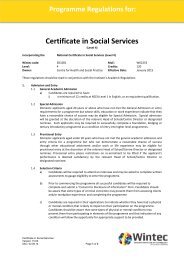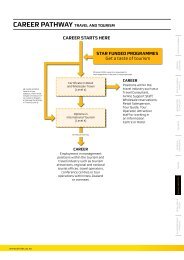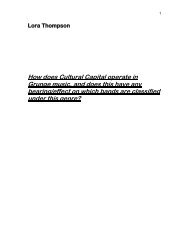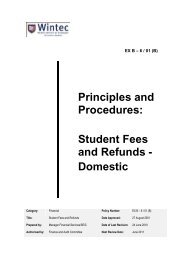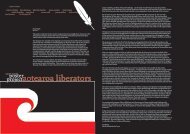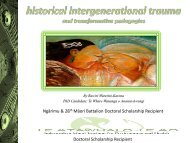2012 wintec annual report
2012 wintec annual report
2012 wintec annual report
Create successful ePaper yourself
Turn your PDF publications into a flip-book with our unique Google optimized e-Paper software.
WINTEC ANNUAL<br />
REPORT <strong>2012</strong><br />
45<br />
• Fair value through surplus or deficit;<br />
• Loans and receivables; and<br />
• Fair value through other comprehensive income.<br />
Classification of the financial asset depends on the purpose<br />
for which the instruments were acquired.<br />
Financial assets at fair value through surplus or deficit<br />
Financial assets at fair value through surplus or deficit include<br />
financial assets held for trading. A financial asset is classified in<br />
this category if it is acquired principally for the purpose of selling<br />
in the short-term or is part of a portfolio that is managed together<br />
and for which there is evidence of short-term profit taking.<br />
Financial assets acquired principally for the purpose of selling in<br />
the short-term or as part of a portfolio classified as held for trading<br />
are classified as a current asset. After initial recognition financial<br />
assets in this category are measured at their fair values with gains<br />
or losses on re-measurement recognised in the surplus or deficit.<br />
Loans and receivables (including cash and cash equivalents<br />
and debtors and other receivables)<br />
Loans and receivables are non-derivative financial assets with<br />
fixed or determinable payments that are not quoted in an active<br />
market. They are included in current assets, except for maturities<br />
greater than 12 months after the balance date, which are<br />
included in non-current assets. Related party receivables that are<br />
repayable on demand are classified as a non-current asset because<br />
repayment of the receivable is not expected within 12 months of<br />
balance date.<br />
After initial recognition, loans and receivables are measured<br />
at amortised cost using the effective interest method less any<br />
provision for impairment. Gains and losses when the asset is<br />
impaired or de-recognised are recognised in the surplus or deficit.<br />
Financial assets at fair value through other comprehensive income<br />
Financial assets at fair value through other comprehensive<br />
income are those that are designated as fair value through other<br />
comprehensive income or are not classified in any of the other<br />
categories above. They are included in non-current assets unless<br />
management intends to dispose of the investment within 12<br />
months of balance date. The Institute and Group designate in this<br />
category:<br />
• Investments that it intends to hold long-term but which may be<br />
realised before maturity; and<br />
• Shareholdings that it holds for strategic purposes.<br />
After initial recognition these investments are measured at<br />
their fair value, with gains and losses recognised in other<br />
comprehensive income, except for impairment losses, which<br />
are recognised in the surplus or deficit.<br />
On de-recognition the cumulative gain or loss previously<br />
recognised in other comprehensive income is reclassified from<br />
equity to the surplus or deficit.<br />
Impairment of financial assets<br />
At each balance date, the Institute and Group assess whether<br />
there is any objective evidence that a financial asset or Group of<br />
financial assets is impaired. Any impairment losses are recognised<br />
in surplus or deficit.<br />
Loans and receivables (including cash and cash equivalents<br />
and debtors and other receivables)<br />
Impairment of a loan or a receivable is established when there is<br />
objective evidence that the Institute and Group will not be able to<br />
collect amounts due according to the original terms of the debt.<br />
Significant financial difficulties of the debtor, probability that<br />
the debtor will enter into bankruptcy, and default in payments<br />
are considered indicators that the asset is impaired. The<br />
amount of the impairment is the difference between the asset’s<br />
carrying amount and the present value of estimated future cash<br />
flows, discounted using the original effective interest rate. For<br />
debtors and other receivables, the carrying amount of the asset<br />
is reduced through the use of an allowance account, and the<br />
amount of the loss is recognised in the surplus or deficit. When the<br />
receivable is uncollectable, it is written-off against the allowance<br />
account. Overdue receivables that have been renegotiated are<br />
reclassified as current (i.e. not past due). For other financial<br />
assets, impairment losses are recognised directly against the<br />
instrument’s carrying amount.<br />
Financial assets at fair value through other comprehensive income<br />
For equity investments, a significant or prolonged decline in the<br />
fair value of the investment below its cost is considered objective<br />
evidence of impairment. For debt investments, significant<br />
financial difficulties of the debtor, probability that the debtor will<br />
enter into bankruptcy, and default in payments are considered<br />
objective indicators that the asset is impaired.<br />
FINANCIAL PERFORMANCE<br />
1<br />
2<br />
3<br />
4<br />
5<br />
6<br />
7<br />
8<br />
9<br />
10


